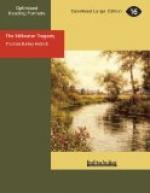A secret visit to the studio seemed equally difficult by day and night. In the former case he was nearly certain to be deranged by the servants, and in the latter a light in the unoccupied room would alarm any of the household who might chance to awaken. From the watchman no danger was to be apprehended, as the windows of the extension were not visible from the street.
Mr. Taggett finally decided on the night as the more propitious time for his attempt,—a decision which his success justified. A brilliant moon favored the in-door part of the enterprise, though it exposed him to observation in his approach from the marble yard to the veranda.
With the dense moonlight streaming outside against the window-shades, he could safely have used a candle in the studio instead of the screened lantern which he had provided. Mr. Taggett passed three hours in the workshop,—the last hour in waiting for the moon to go down. Then he stole through the marble yard into the silent street, and hurried home, carrying two small articles concealed under his blouse. The first was a chisel with a triangular piece broken out of the centre of the bevel, and the other was a box of safety-matches. The peculiarity of this box of matches was—that just one match had been used from it.
Mr. Taggett’s work was done.
The last seven pages of the diary were devoted to a review of the case, every detail of which was held up in various lights, and examined with the conscientious pains of a lapidary deciding on the value of a rare stone. The concluding entries ran as follow:—
"Tuesday Night. Here the case passes into other hands. I have been fortunate rather than skillful in unmasking the chief actor in one of the most singular crimes that ever came under my investigation. By destroying three objects, very easily destroyed, Richard Shackford would have put himself beyond the dream of suspicion. He neglected to remove these dumb witnesses, and now the dumb witnesses speak! If it could be shown that he was a hundred miles from Stillwater at the time of the murder, instead of in the village, as he was, he must still be held, in the face of the proofs against him, accessory to the deed. These proofs, roughly summarized, are:—
"First. The fact that he had had an altercation with his cousin a short time previous to the date of the murder,—a murder which may be regarded not as the result of a chance disagreement, but of long years of bitter enmity between the two men.
"Secondly. The fact that Richard Shackford had had an appointment with his cousin on the night the crime was committed, and had concealed that fact from the authorities at the time of the coroner’s inquest.
"Thirdly. That the broken chisel found in the private workshop of the accused explains the peculiar shape of the wound which caused Lemuel Shackford’s death, and corresponds in every particular with the plaster impression taken of that wound.




